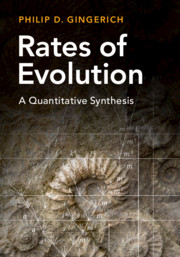Book contents
- Rates of Evolution
- Reviews
- Rates of Evolution
- Copyright page
- Dedication
- Contents
- Preface
- Acknowledgments
- 1 Introduction
- 2 Variation in Nature
- 3 Evolutionary Time
- 4 Random Walks and Brownian Diffusion
- 5 Temporal Scaling and Evolutionary Mode
- 6 Directional Selection, Stabilizing Selection, and Random Drift
- 7 Phenotypic Change in Experimental Lineages
- 8 Phenotypic Change Documented in Field Studies
- 9 Phenotypic Change in the Fossil Record
- 10 A Quantitative Synthesis
- 11 Retrospective on Punctuated Equilibria
- 12 Genetic Models
- 13 Independent Contrasts: Phylogeny’s Influence on Phenotypes
- 14 Rate Perspective on Early Bursts of Evolution
- 15 Summary and Conclusions
- Appendix
- References
- Index
12 - Genetic Models
Published online by Cambridge University Press: 29 April 2019
- Rates of Evolution
- Reviews
- Rates of Evolution
- Copyright page
- Dedication
- Contents
- Preface
- Acknowledgments
- 1 Introduction
- 2 Variation in Nature
- 3 Evolutionary Time
- 4 Random Walks and Brownian Diffusion
- 5 Temporal Scaling and Evolutionary Mode
- 6 Directional Selection, Stabilizing Selection, and Random Drift
- 7 Phenotypic Change in Experimental Lineages
- 8 Phenotypic Change Documented in Field Studies
- 9 Phenotypic Change in the Fossil Record
- 10 A Quantitative Synthesis
- 11 Retrospective on Punctuated Equilibria
- 12 Genetic Models
- 13 Independent Contrasts: Phylogeny’s Influence on Phenotypes
- 14 Rate Perspective on Early Bursts of Evolution
- 15 Summary and Conclusions
- Appendix
- References
- Index
Summary
- Type
- Chapter
- Information
- Rates of EvolutionA Quantitative Synthesis, pp. 298 - 311Publisher: Cambridge University PressPrint publication year: 2019



